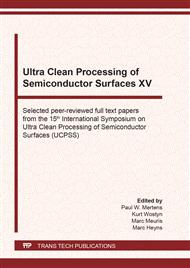p.84
p.89
p.95
p.101
p.107
p.113
p.119
p.127
p.133
Silicon Corrosion during Selective Silicon Nitride Etch with Hot Diluted Hydrofluoric Acid
Abstract:
Silicon nitride is commonly etched by hot orthophosphoric acid. Hot diluted hydrofluoric acid is hereby used as an alternative. Nonetheless, in presence of silicon surfaces, some corrosion has been evidenced, degrading significantly active areas during the STI (Shallow Trench isolation) integration. Oxygen in hot deionized water or hot HF generates this corrosion and selecting a relevant chemical oxide before dispensing hot diluted HF is key in solving the concern.
Info:
Periodical:
Pages:
107-112
Citation:
Online since:
February 2021
Price:
Сopyright:
© 2021 Trans Tech Publications Ltd. All Rights Reserved
Share:
Citation:


